In this article, we will learn how to operate over files using a C program. A single C file can read, write, move, and create files in our computer easily using a few functions and elements included in the C File I/O system. We can easily manipulate data in a file regardless of whether the file is a text file or a binary file using functions like fopen(), fclose(), fprintf(), fscanf(), getc(), putc(), getw(), fseek(), etc.
What are files in C?
A file is used to store huge data. C provides multiple file management functions like file creation, opening and reading files, Writing to the file, and closing a file. The file is used to store relevant data and file handling in C is used to manipulate the data.
Types of Files in C
There are mainly two types of files that can be handled using File Handling in C as mentioned below:
- Text Files
- Binary Files
1. Text Files
These are simple text files that are saved by the (.txt) extension and can be created or modified by any text editor. Text file stores data in the form of ASCII characters and is used to store a stream of characters.
2. Binary Files
It is stored in binary format instead of ASCII characters. Binary files are normally used to store numeric Information (int, float, double). Here data is stored in binary form i.e, (0’s and 1’s).
C Files Operations
C Files can perform multiple useful operations that are mentioned below:
- Creation of a new file (fopen with attributes as “a” or “a+” or “w” or “w+”).
- Opening an existing file (fopenopen).
- Reading from file (fscanf or fgets).
- Writing to a file with fprintf or fputs.
- Moving file pointer associated with a given file to a specific position. (fseek, rewind).
- Closing a file (close).
File Pointer declaration
For performing operations on the file, a special pointer called File pointer is used that can be declared as:
FILE file_ptr;
We can open the file as
file_ptr = fopen("fileName.txt", "w");
File Modes in C
The second parameter i.e, “w” can be changed according to the table below:
| Opening Modes |
Description |
| r |
Searches file. If the file is opened successfully fopen( ) loads it into memory and sets up a pointer that points to the first character in it. If the file cannot be opened fopen( ) then it returns NULL. |
| rb |
Open for reading in binary mode. If the file does not exist then fopen( ) will return NULL. |
| w |
Searches file. Contents are overwritten if the file exists. A new file is created if the file doesn’t exist. Returns NULL, if unable to open the file. |
| wb |
Open for writing in binary mode. Its contents are overwritten if the file exists, else the file will be created. |
| a |
Searches file. If the file is opened successfully fopen( ) loads it into memory and sets up a pointer that points to the last character in it. If the file doesn’t exist, a new file is created. Returns NULL, if unable to open the file. |
| ab |
Open for append in binary mode. Data is added to the end of the file. A file will be created if it does not exist. |
| r+ |
Searches file. It is opened successfully fopen( ) loads it into memory and sets up a pointer that points to the first character in it. If it is unable to open the file it Returns NULL. |
| rb+ |
Open for both reading and writing in binary mode. fopen( ) returns NULL if the file does not exist. |
| w+ |
Searches file. Its contents are overwritten if the file exists. A new file is created if the file doesn’t exist. Returns NULL, if unable to open the file. |
| wb+ |
Open for both reading and writing in binary mode. Contents are overwritten if the file exists. It will be created if the file does not exist. |
| a+ |
Searches file. If the file is opened successfully fopen( ) loads it into memory and sets up a pointer that points to the last character in it. If the file doesn’t exist, a new file is created. Returns NULL, if unable to open the file. |
| ab+ |
Open for both reading and appending in binary mode. A file will be created if the file does not exist. |
If you want to handle binary files then access modes like “rb”, “wb”, “ab”, “rb+”, r+b”, “wb+”, “w+b”, “ab+”, “a+b” will be used mostly.
Opening a file in C
To perform the opening and creation of a file in c we can use the fopen() function which comes under stdio.h header file.
Syntax:
p = fopen("fileopen", "mode");
Example:
p = fopen("Hello.txt", r);
Creating a File in C
As now we know how to open a file using fopen() now the question arises about creation. The creation of a file is as simple as opening a file. As, if the while opening a file for writing or appending is done with either write(“w”) or append(“a”) mode then in the case where the file doesn’t exist a new file is created.
Example:
C
#include <stdio.h>
#include <stdlib.h>
int main()
{
FILE* ptr;
ptr = fopen("./Hello.txt", "w");
if (ptr == NULL) {
printf("Error Occurred While creating a "
"file !");
exit(1);
}
fclose(ptr);
printf("File created\n\n");
return 0;
}
|
Output:
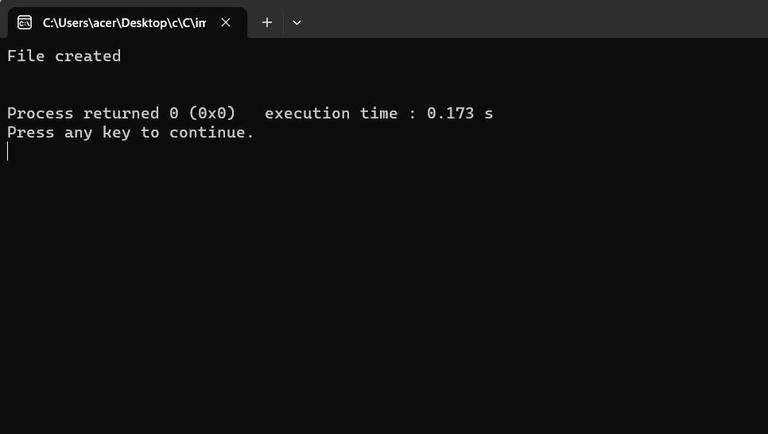
The output of the Creating a File in C
File Created:
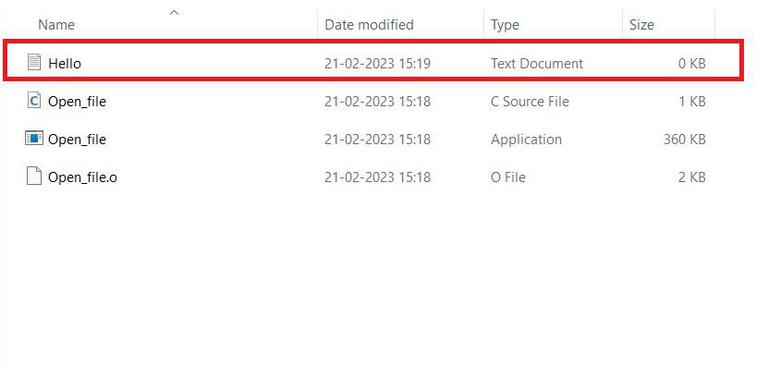
Hello.txt file created using the C program
Writing a File in C
1. Writing to a text file in C
fprintf() and fscanf() are used to read and write in a text file in C programming. They expect a pointer to the structure FILE since they are file versions of print() and scanf().
C
#include <stdio.h>
#include <stdlib.h>
int main()
{
FILE* ptr;
ptr = fopen("./Hello.txt", "w+");
if (ptr == NULL) {
printf("Error Occurred While writing to a text "
"file !");
exit(1);
}
char str[] = "This is all the Data to be inserted in "
"File by GFG.";
fputs(str, ptr);
fclose(ptr);
printf("Data Written Inside the file\n\n");
return 0;
}
|
Output:

The output of Writing to a text file in C
File Created:
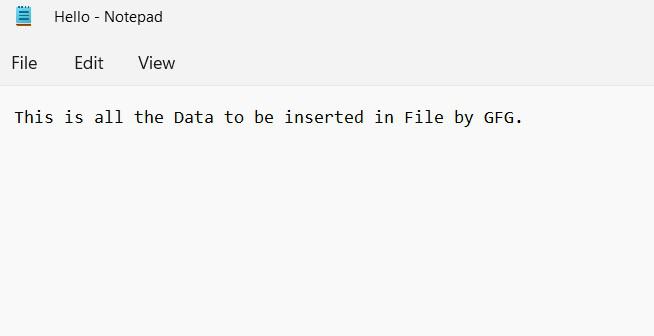
Writing to a text file in C
The above program takes a string from a user and stores it in text_file.text.After compiling this program a text file named temp_text.txt will be created in the C_Program folder. Inside the file, we can see the string that we entered.
2. Writing to a Binary File
fwrite() function takes four arguments address of data, size of the data which is to be written on the disk, number of data types, and a pointer to the file where we want to write.
Syntax:
fwrite(const void *ptr,size_of_elements,number_of_elements, FILE *a_file);
Below is the C program to write to a binary file:
C
#include <stdio.h>
#include <stdlib.h>
struct Num {
int n1, n2;
};
int main()
{
int n;
struct Num obj;
FILE* fptr;
if ((fptr = fopen("temp.bin", "wb")) == NULL) {
printf("Error! opening file");
exit(1);
}
for (n = 1; n < 10; n++) {
obj.n1 = n;
obj.n2 = 12 + n;
fwrite(&obj, sizeof(struct Num), 1, fptr);
}
fclose(fptr);
printf("Data in written in Binary File\n\n");
return 0;
}
|
Output:

The output of Writing to a Binary File
Image of created file:
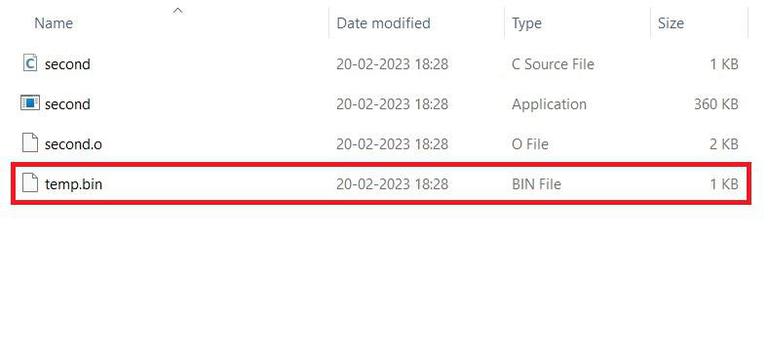
.bin file created with the data
Note: fread() is used to read from a binary file and fwrite() is used to write to a file on the disk.
Reading File in C
1. Reading text files in C
Below is the C program to read the contents from the file:
C
#include <stdio.h>
#include <stdlib.h>
int main()
{
char str[80];
FILE* ptr;
ptr = fopen("Hello.txt", "r");
if (ptr == NULL)
{
printf("Error While opening file");
exit(1);
}
if(fgets(str, 80, ptr) != NULL)
{
puts(str);
}
fclose(ptr);
return 0;
}
|
Output:

The output of Reading text files in C
2. Reading from a Binary File
fread() function also takes four arguments that are similar to fwrite() function in C Programming.
Syntax:
fwrite(const void *ptr,size_of_elements,number_of_elements, FILE *a_file);
Below is the C program to read from a binary file:
C
#include <stdio.h>
#include <stdlib.h>
struct Num
{
int n1, n2;
};
int main()
{
int n;
struct Num obj;
FILE* fptr;
if ((fptr = fopen("temp.bin", "rb")) == NULL)
{
printf("Error! opening file");
exit(1);
}
for (n = 1; n < 10; ++n)
{
fread(&obj, sizeof(struct Num), 1, fptr);
printf("n1: %d\tn2: %d\n", obj.n1, obj.n2);
}
fclose(fptr);
return 0;
}
|
Output:
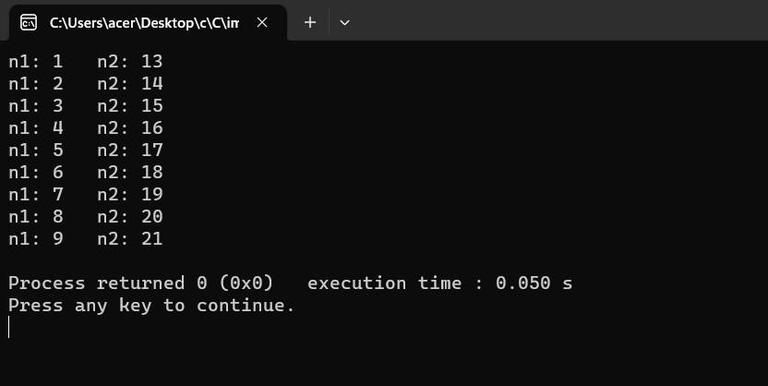
The output of Reading from a Binary File
Explanation: In the above program, we have read the same file GFG.bin and are looping through records one by one. We read a single Num record of Num size from the file pointed by *fptr into the structure Num. We’ll get the same record that we inserted in the previous program.
Moving File Pointers to Specific Positions
fseek() and rewind() are the two methods in C programming that can be used to move the file pointer. Let us check both methods:
1. fseek() in C Programming
fseek() function is used to set the file pointer to the specified offset and write data into the file.
Syntax:
int fseek(FILE *stream, long int offset, int whence);
Here,
- whence can be SEEK_SET, SEEK_CUR and SEEK_END.
- SEEK_END: It denotes the end of the file.
- SEEK_SET: It denotes starting of the file.
- SEEK_CUR: It denotes the file pointer’s current position.
Below is the C program to implement fseek():
C
#include <stdio.h>
#include <stdlib.h>
int main()
{
char str[80];
FILE* ptr;
ptr = fopen("Hello.txt", "w+");
fputs("Welcome to GeeksforGeeks", ptr);
fseek(ptr, 11, SEEK_SET);
fputs("Programming ", ptr);
fclose(ptr);
ptr = fopen("Hello.txt", "r+");
if (fgets(str, 80, ptr) != NULL) {
puts(str);
}
fclose(ptr);
return 0;
}
|
Output:
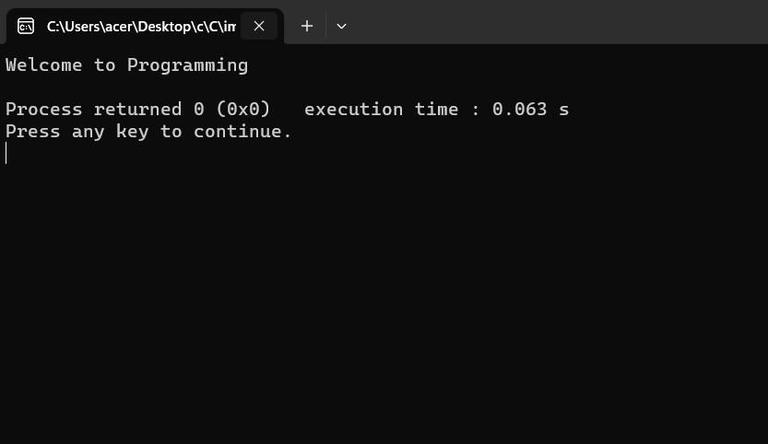
The output of fseek() in C
Image of the File:
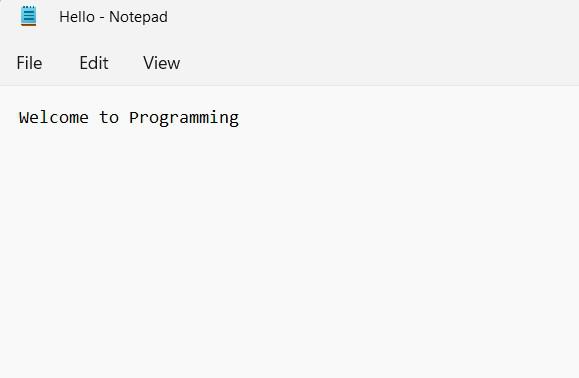
Changes in the file
2. rewind() in C
rewind() function sets the file pointer to the beginning of the file.
Syntax:
void rewind(FILE *stream);
Below is the C Program to implement rewind():
C
#include <stdio.h>
#include <stdlib.h>
int main()
{
char str[200];
FILE* ptr;
ptr = fopen("Hello.txt", "w+");
fputs("Welcome to GeeksforGeeks", ptr);
fclose(ptr);
ptr = fopen("Hello.txt", "r+");
if (fgets(str, 200, ptr) != NULL) {
puts(str);
}
rewind(ptr);
if (fgets(str, 200, ptr) != NULL) {
puts(str);
}
fclose(ptr);
return 0;
}
|
Output:

The output of rewind() in C
Image of the File:
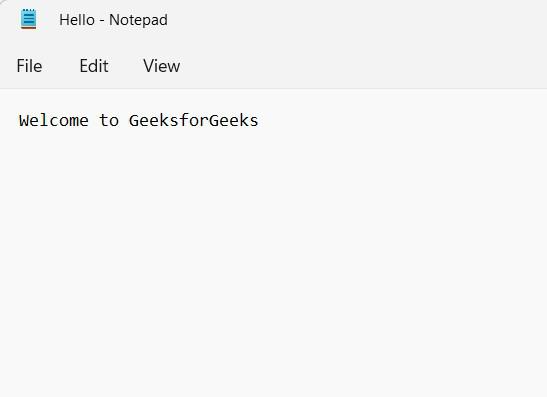
File after running the program
FAQs on C File I/O
1. How to open a file in C?
File in C can be opened using file pointer and fopen function. In the first step, we need to declare the file pointer and in the second step we can use fopen with the name of the file to be opened and the mode(read, write, append) for using the file.
Example:
FILE file_ptr;
file_ptr = fopen("fileName.txt", "w");
2. How to create a file in C?
The file can be created using two modes: append and write. We need to simply open the file with either mode to create the file.
3. How to read a file in C?
File in C can be read by opening the file in read mode. And we can get strings from the file using the fgets function.
4. How to write to a file in C?
File in C can be read by opening the file in read mode. And we can get strings from the file using the fputs function.
5. What is the use of fseek() in C?
fseek() is used for moving file pointer associated with a given file to a specific position in a file.
6. What are modes in C file io?
Modes in C file IO defines the functionality of the file pointer,i.e. means whether it can read, write, append, etc in a file.
7. What are different operations which can be performed on a file in C?
There are multiple operations that can be performed in a file which are creating, opening, reading, writing, and moving.
Like Article
Suggest improvement
Share your thoughts in the comments
Please Login to comment...